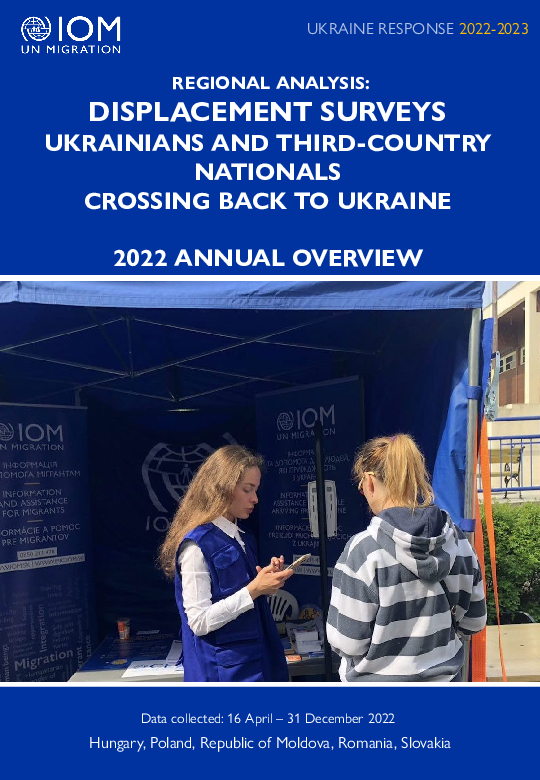-
Countries
-
Data and Analysis
-
Special Focus
-
Crisis Responses
Ukraine Response — Regional Annual Overview — Ukrainian Refugees and TCNs crossing to Ukraine in 2022
Starting on 24 February 2022, the Russian full-scale invasion of Ukraine triggered an unprecedented humanitarian crisis and generated large scale displacement both within Ukraine and to the neighbouring countries. As of 23 January 2023,1 5.4 million persons were internally displaced in Ukraine. Moreover, in Mid-January 2023 nearly eight million refugees from Ukraine were recorded across Europe.2 According to available administrative data, more than 17 million border crossings of Ukrainian and Third-Country refugees and migrants were reported from Ukraine into the neighbouring countries since February 2022. At the same time, around 5.2 million persons were estimated to be returnees including both from other locations within Ukraine and self-reported from abroad as of 5 December 2022.3 Nearly nine million cross-border movements were registered from Poland, Romania, Slovakia, and the Republic of Moldova among the neighbouring countries into Ukraine as of the end of January 2023.4
IOM has deployed its Displacement Tracking Matrix (DTM) tools since mid-April 2022 to collect individual surveys in neighbouring countries with persons crossing into Ukraine, with the aim to improve the understanding of main profiles, displacement patterns, intentions and needs of those moving into Ukraine.
This report is based on 24,393 valid surveys collected by IOM’s DTM in five countries, with Ukrainian and Third-Country refugees and migrants crossing to Ukraine, between 16 April and 31 December 2022: 8,743 in Romania, 7,131 in the Republic of Moldova 6,807 in Poland, 1,037 in Hungary, and 675 in Slovakia. Total results are weighted as per the number of border crossings into Ukraine from each country of the survey, during the afore-mentioned period. Results are also presented by period of the data collection to show the evolution of profiles, needs and intentions from Quarter 2 of 2022 (from April to June), to Quarter 3 (July-September) and Quarter 4 (October-December).
Movements back to Ukraine can be pendular, and do not necessarily indicate sustainable intentions to stay as the situation across the country remains highly volatile and unpredictable. Hence, individuals surveyed while crossing into Ukraine from neighbouring countries are not necessarily returnees, and conclusions on definitive trends cannot be drawn.
For a complementary discussion on returnees within Ukraine, after internal or international displacement, please check the latest DTM Ukraine Return Report (January 2023) and the Factsheet Conditions of Return Assessment (February 2023).

